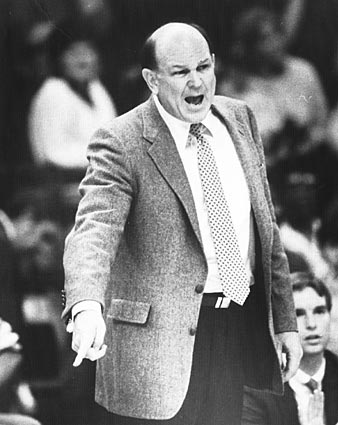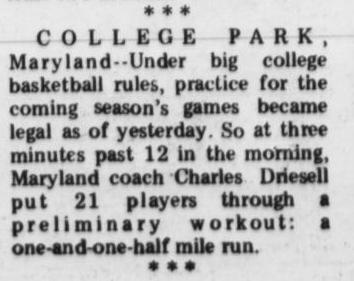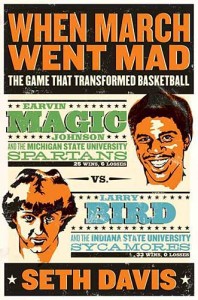Posted by nvr1983 on October 14th, 2010

Rush The Court is back with another edition of One on One: An Interview Series, which we will bring you periodically throughout the year. If you have any specific interview requests or want us to interview you, shoot us an email at rushthecourt@yahoo.com.
Few college coaches have had careers with as much success at as many different venues as Charles “Lefty” Driesell. After playing at Duke under Harold Bradley, he coached a few years of high school basketball in Virginia finishing with a 57-game winning streak at Newport News High School before accepting a head coaching position at Davidson where he coached for nine seasons compiling a 176-75 record leading the Wildcats from the bottom of the Southern Conference to the Elite Eight in back-to-back seasons (yes there was basketball at Davidson before Stephen Curry). Following the 1969 season, Driesell moved to Maryland, which is where most basketball fans associate him with. After a rough start his first two years in College Park where his teams went a combined 27-25 (10-18 in the ACC), Driesell quickly turned things around making it to the NCAA Elite Eight twice more and winning the NIT in a span of four seasons at a time when only the ACC Tournament champion was awarded a bid to the NCAA Tournament. This hit the Terrapins especially hard in 1974 when they were a top five team who lost what many consider to be one of the greatest college games of all-time, a 103-100 loss in overtime to David Thompson and eventual national champion North Carolina State. It was just prior to the start of that run in 1971 that Driesell instituted what would come to be viewed as the predecessor of Midnight Madness when he gathered his team a few minutes after midnight on the first day of practice for a training run around the track. In the subsequent 39 years, the tradition has transformed from a humble event into a media spectacle. Following that four-year run, Driesell’s most notable success came in the mid-1980s when the Terrapins re-emerged in the national consciousness with the play of Len Bias and his subsequent passing just after he was drafted by the Boston Celtics. After leaving Maryland in the wake of the Bias scandal, Driesell was away from the sidelines for two years before returning to coach at James Madison and later Georgia State, making the NCAA Tournament three more times including a 2001 win at GSU over Wisconsin in the first round of the NCAA Tournament. For his contributions to the game, Driesell was inducted into the University of Maryland Athletic Hall of Fame in 2002 and the National Collegiate Basketball Hall of Fame in 2008. Earlier this week we caught up with him to discuss the origins of Midnight Madness and other issues relating to the current state of college basketball.

Driesell Helped Build Progams at Four Schools
RTC: You started “Midnight Madness” in 1971 based on a 1.5 mile run, which it seems like you continued all the way through your Georgia State days. Could you talk a little bit about your motivation for coming up with the idea and what your thoughts are on what it has become today?
LD: My thought at the time was to make sure that the guys, when practice started on October the 15th [were ready]. We didn’t have all this conditioning and weightlifting like they have now. Until October the 15th you couldn’t have anything to do with the players. Right now they start conditioning with four hours per week for team practice or something. You know what I’m saying. Back then you couldn’t do anything until October the 15th. You couldn’t hold meetings. You couldn’t lift weights with them. You couldn’t run or condition them. It was a way for me to encourage them to get in shape for October the 15th when practice started. I always ran them a mile on October the 15th. That kind of messed up my practice on that day. So George Raveling and I were talking and we said why don’t we just run the mile at 12:01 and then we can practice at 3 o’clock that afternoon. So that’s what we did for the first year. You know we had cars on the track with lights on so nobody would cut the course, but I heard that [Len] Elmore did. So I don’t know if we did that one year or two years, but Mo Howard said, “Hey Coach. Why don’t we just have a scrimmage at midnight next year?” because they wanted to get out of the running. So I said, “Yeah. Alright we can do that.” So we did the next year. We had a scrimmage and had seven or eight thousand kids. . . In fact we had a lot of kids watching us run that night [in 1971]. It was like my second year at Maryland. We were going to have a good team. We had [Tom] McMillen and Elmore coming up as sophomores. We had our undefeated freshman team the year before so everybody was excited. We had a lot of people just watching us run that first year so Mo said “Let’s have a scrimmage at midnight next year” so we did and we had about ten thousand people show up and from then on we filled it up. So that was kind of the way we got it started. It let us get a jump on everybody. I told them we’re going to practice before anybody else in the country and we’re going to be playing on the last day in the NCAA Finals. You know just a little motivational thing.

From the Oct 16, 1971 edition of The Virgin Islands Daily News
RTC: Could you talk a little bit about its evolution and what it has become now? It’s on ESPN, ESPN2, ESPNU, all of the ESPNs, and a lot of other channels. What are your thoughts on that?
LD: I think it’s great. It has helped promote basketball. It gets the students and the fans thinking basketball in the middle of football and baseball and everything. I think it’s great. The only thing that I don’t like is that they let them have it at 5 o’clock in the afternoon instead of midnight. I think midnight created more interest because kids like to stay up late. I think one of the best teams I ever had was at James Madison and we played a game at midnight. I see that a couple teams play games at midnight this year. I think that’s great because college kids like to stay up late when they should be in bed. At least they are better off at a basketball game than somewhere else. I wish it was still at midnight. A lot of people call it “Basketball Madness,” but it really is “Midnight Madness.”
Read the rest of this entry »
| Regular Features, rtc interviews
| Tagged: alabama, chris webber, citadel, david thompson, davidson, duke, george raveling, georgia state, harold bradley, james madison, lefty driesell, len bias, len elmore, maryland, memphis, michigan, mo howard, nc state, north carolina state, stephen curry, the citadel, tom mcmillen, wisconsin
Share this story















































